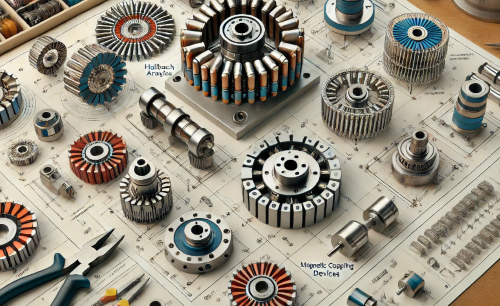6 Common Types of Magnetic Assemblies
Magnetic assemblies are essential components used in a variety of applications to leverage the power of magnets for efficient and reliable performance. These assemblies are designed to enhance functionality, safety, and convenience across different industries. Here, we explore six common types of magnetic assemblies, including Halbach arrays and voice coil motors.

1. Magnetic Couplings
Description:
Magnetic couplings are devices that transfer torque from one shaft to another without physical contact. They utilize magnetic fields to couple two rotating components, ensuring synchronous rotation. This contactless transfer of torque is especially beneficial in applications where it is crucial to avoid contamination between the driving and driven parts.
Applications:
– Pumps, mixers, and compressors in sealed environments to prevent contamination.
– Industrial machinery where maintaining a contamination-free space is essential.
Related reading: Magnetic Assemblies 101: Types and Applications
2. Magnetic Separators
Description:
Magnetic separators use magnetic fields to separate ferromagnetic materials from non-magnetic ones. These assemblies are vital in industries where metal contamination is a significant concern. Magnetic separators effectively remove metal contaminants from various materials, ensuring product purity and safety.
Applications:
– Recycling, mining, and food processing industries to eliminate metal contaminants.
– Waste management to separate recyclable metals from other materials.
3. Halbach Arrays
Description:
A Halbach array is a special arrangement of permanent magnets that enhances the magnetic field on one side while canceling it on the other side. This unique configuration creates a strong, uniform magnetic field that is highly efficient for specific applications.
Applications:
– Particle accelerators and magnetic levitation systems for a focused and intense magnetic field.
– Brushless motors and magnetic bearings to improve performance and efficiency.
4. Voice Coil Motors
Description:
Voice coil motors (VCMs) are linear actuators that use a coil of wire and a permanent magnet to create motion. When current passes through the coil, it generates a force that moves the coil relative to the magnet. VCMs provide precise and responsive control of motion, making them ideal for high-precision applications.
Applications:
– Hard disk drives for precise positioning of read/write heads.
– Medical devices and optical equipment where precise and controlled movement is required.
5. Magnetic Sensors and Switches
Description:
Magnetic sensors and switches detect the presence, proximity, or movement of magnetic objects. They convert changes in magnetic fields into electrical signals used for control and monitoring purposes. These assemblies are essential for automated systems and safety mechanisms.
Applications:
– Automotive systems for position sensing, speed detection, and anti-lock braking systems (ABS).
– Consumer electronics for proximity sensing and device activation.
6. Magnetic Holders and Clamps
Description:
Magnetic holders and clamps use the attractive force of magnets to hold objects securely in place. These assemblies provide a firm grip and are often adjustable or easily repositionable. They are versatile tools used in various settings to enhance organization and efficiency.
Applications:
– Workshops and manufacturing environments for holding tools, parts, or assemblies.
– Medical settings to secure instruments or devices during procedures.
Conclusion
Magnetic assemblies play a vital role in enhancing the performance and reliability of various systems. Understanding the common types of magnetic assemblies, including magnetic couplings, separators, Halbach arrays, voice coil motors, sensors, and holders, helps in selecting the right solution for specific applications.
Each type offers unique advantages, contributing to improved efficiency, safety, and functionality in its respective field. By leveraging the strengths of these magnetic assemblies, industries can achieve greater innovation and operational excellence. For more information, please check Stanford Magnets.